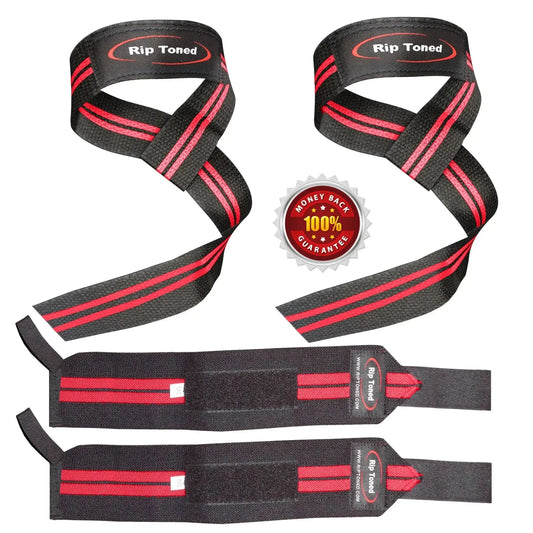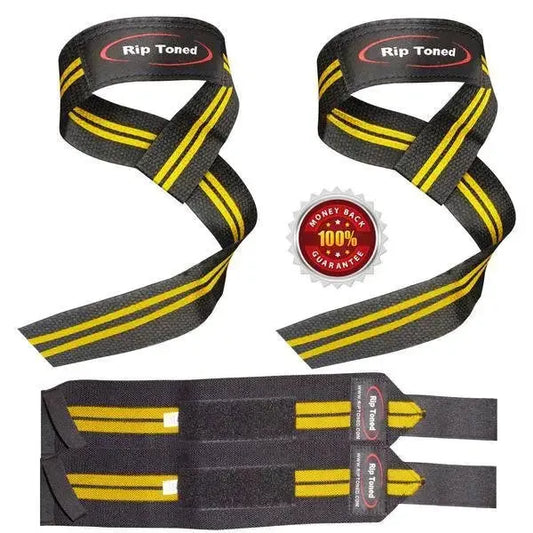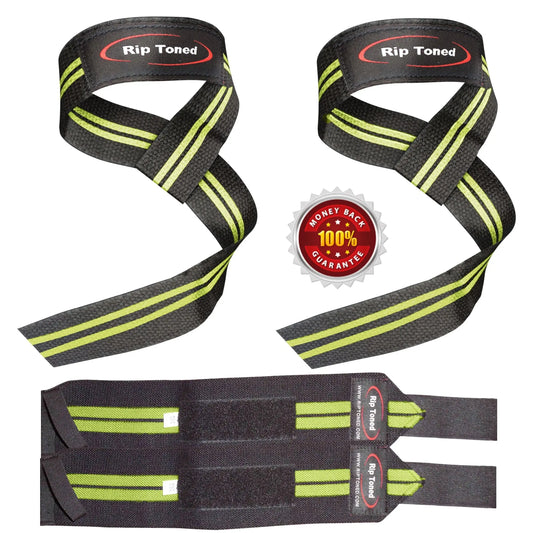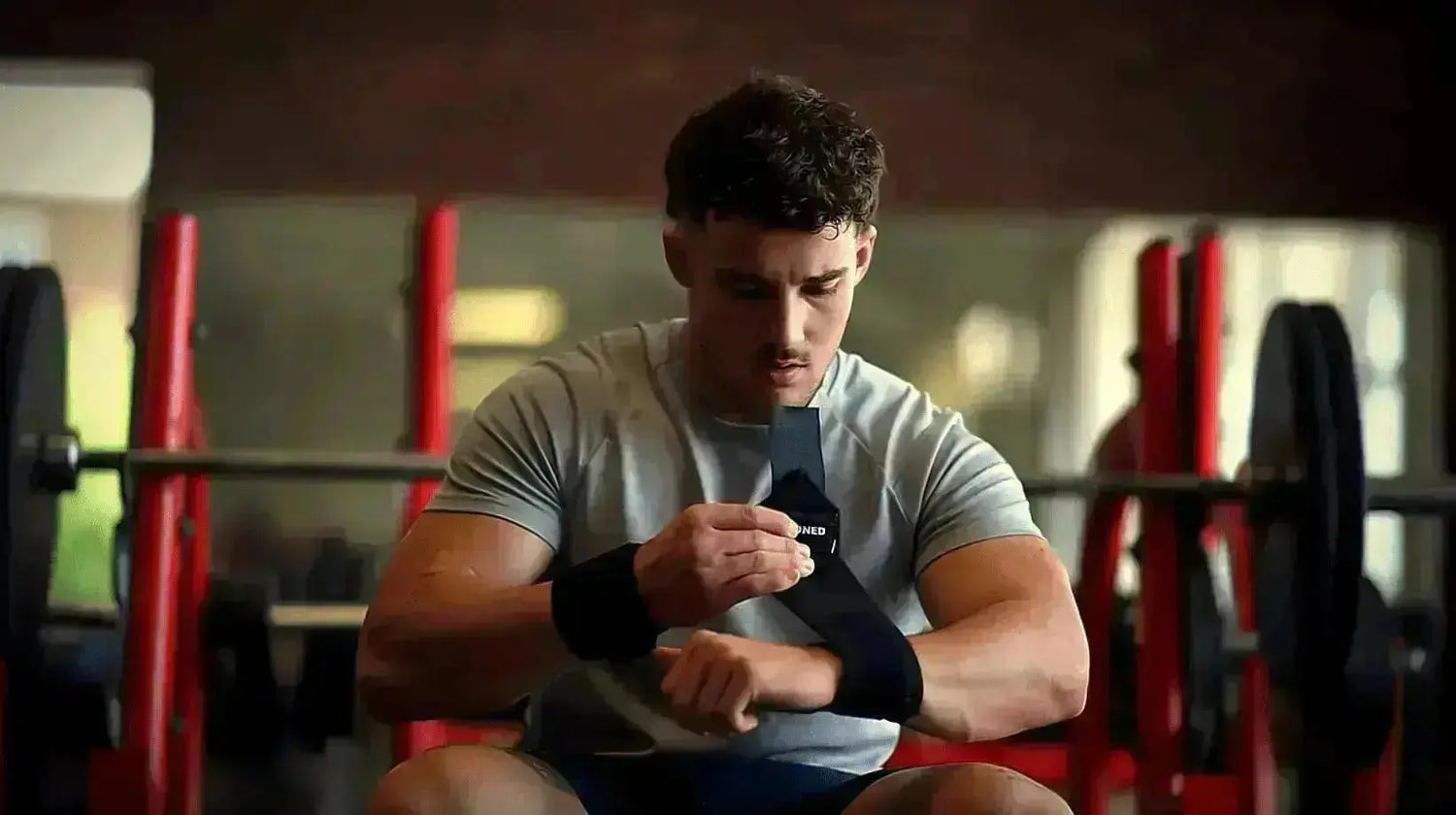
Wrist Wraps Weight Training
Weightlifting Wrist Support
Wrist Wraps Weight Training: Support That Works When You Need It Most
-
Lifting Straps & Wrist Wraps Combo Pack - Red
Lift Harder. Train Smarter. Recover Better — Combo Style. The Rip Toned Wrist...
Regular price $13.99 USDRegular priceUnit price per$19.97 USDSale price $13.99 USDSale -
Lifting Straps & Wrist Wraps Combo Pack - Red Less Stiff (18-inch Wrist Wraps)
Lift Harder. Train Smarter. Recover Better — Combo Style. The Rip Toned Wrist...
Regular price $14.99 USDRegular priceUnit price per$22.97 USDSale price $14.99 USDSold out -
Lifting Straps & Wrist Wraps Combo Pack - Red Stiff (18-inch Wrist Wraps)
Lift Harder. Train Smarter. Recover Better — Combo Style. The Rip Toned Wrist...
Regular price $14.99 USDRegular priceUnit price per$22.97 USDSale price $14.99 USDSale -
Lifting Straps & Wrist Wraps Combo Pack - Yellow
Lift Harder. Train Smarter. Recover Better — Combo Style. The Rip Toned Wrist...
Regular price $13.99 USDRegular priceUnit price per$19.97 USDSale price $13.99 USDSold out -
Lifting Straps & Wrist Wraps Combo Pack - Yellow Fluorescent
Lift Harder. Train Smarter. Recover Better — Combo Style. The Rip Toned Wrist...
Regular price $13.99 USDRegular priceUnit price per$19.97 USDSale price $13.99 USDSale
Wrist Wraps Reviews
-
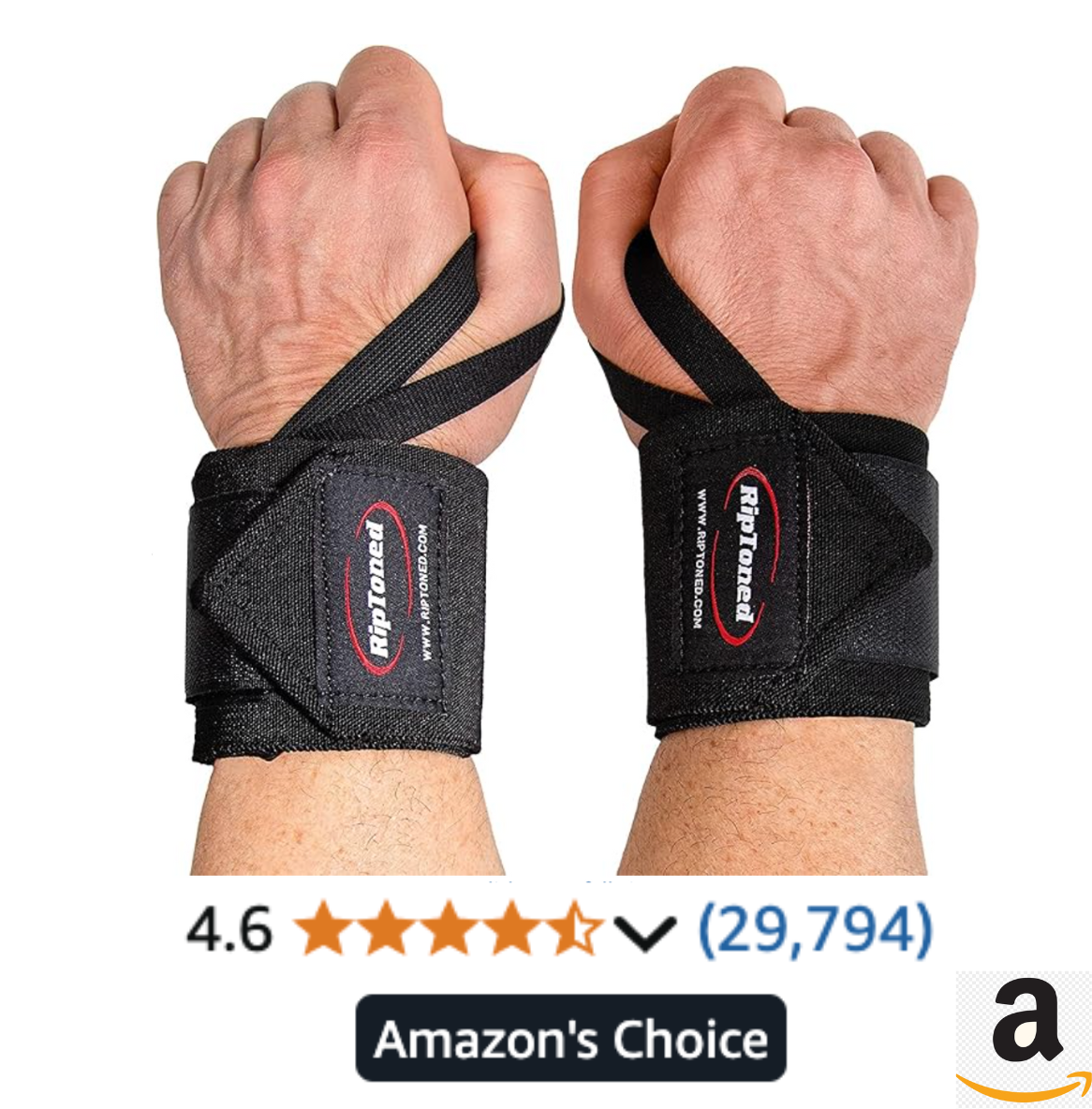
Almost 30K Reviews
Used by over 1,000,000 lifters worldwide
-
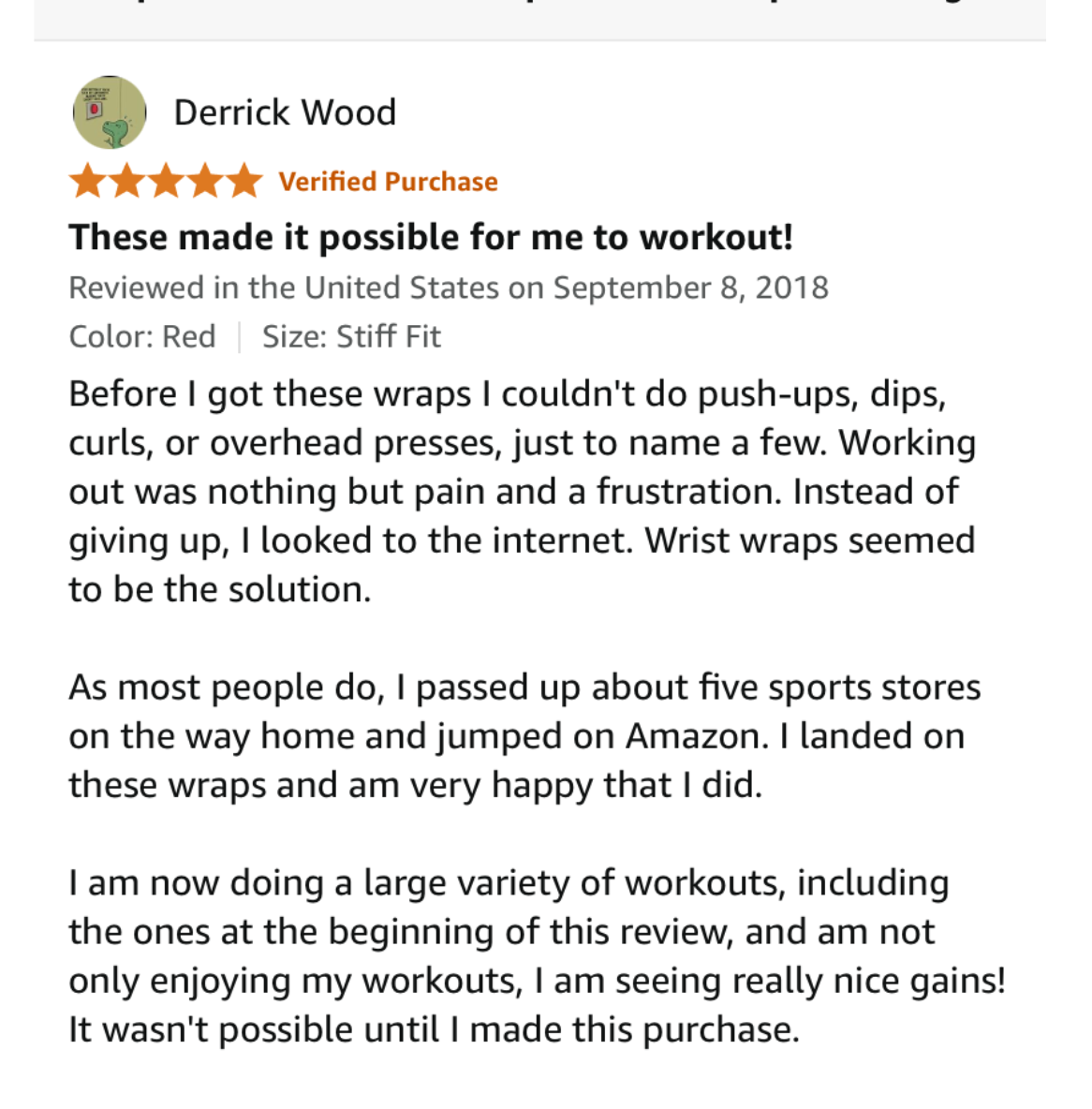
Derrick's Wraps Story
Thousands more similar reviews...
-
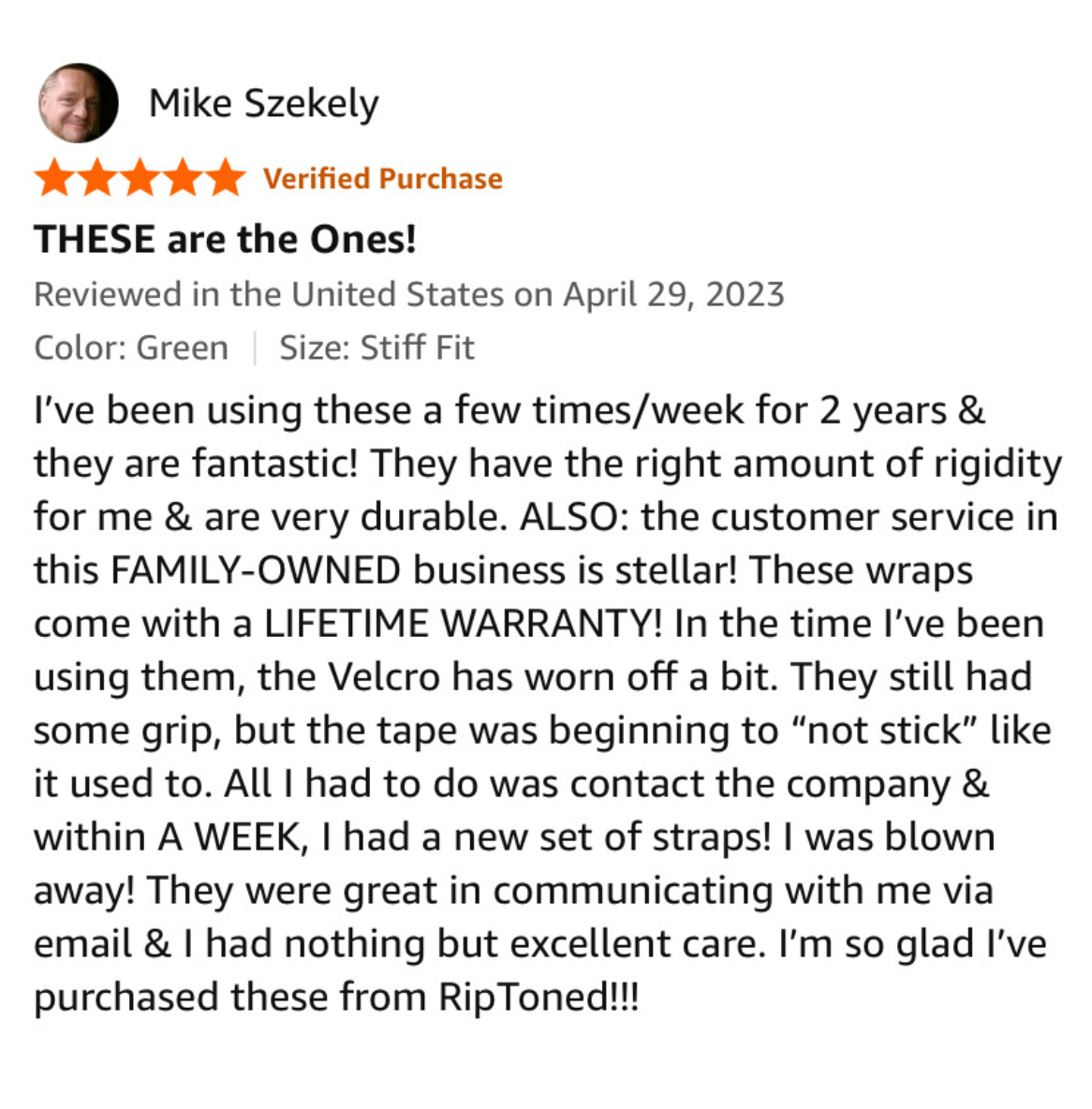
Makes Us Blush a Little :)
"Fantastic" "Durable" "Warranty"... Need More?
Our Wrist Wraps in the Trenches
-
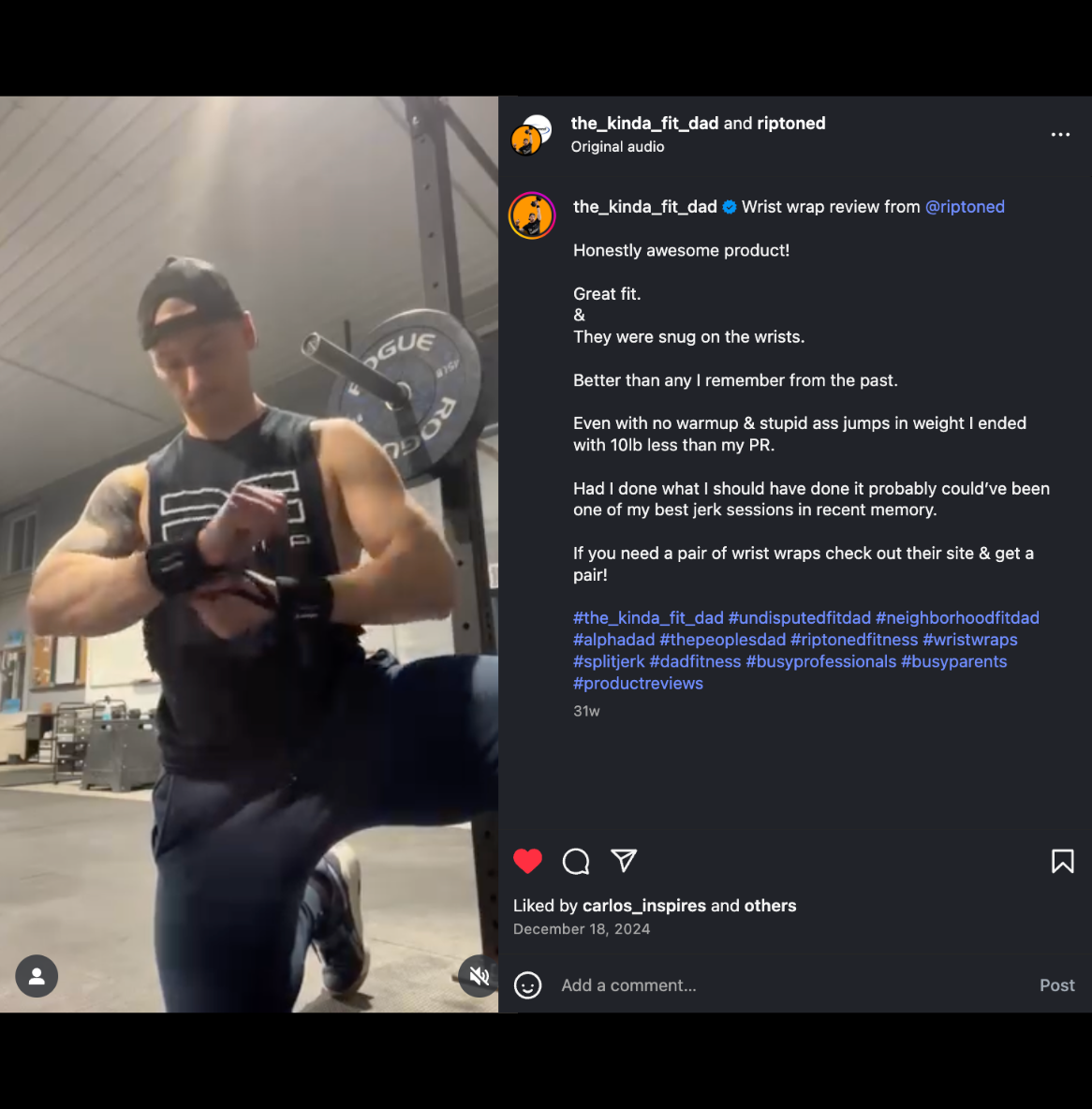
@the_kinda_fit_dad
Rockin' our wrist wraps.
-
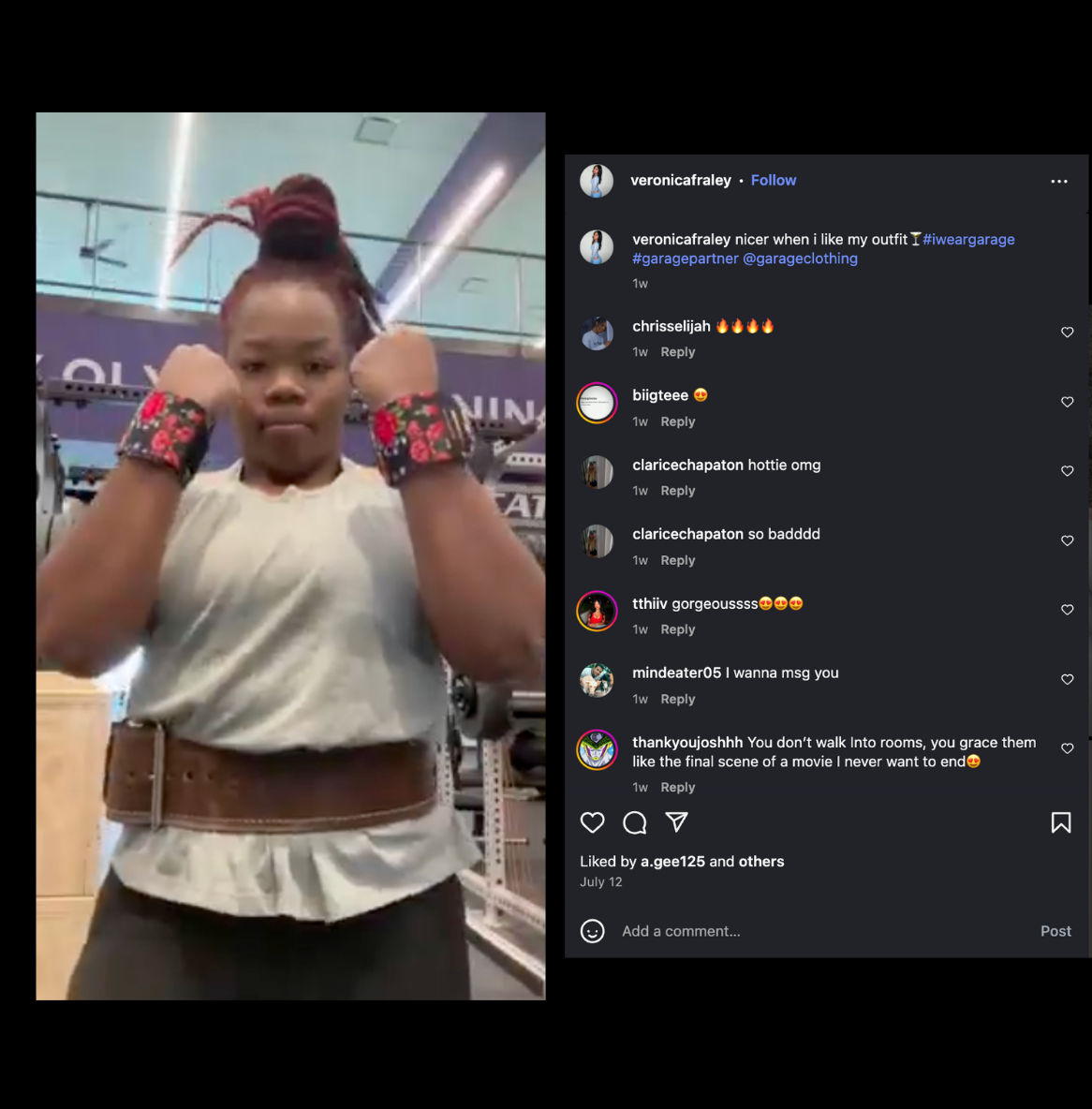
@veronicafraley
Loving the floral wraps
-
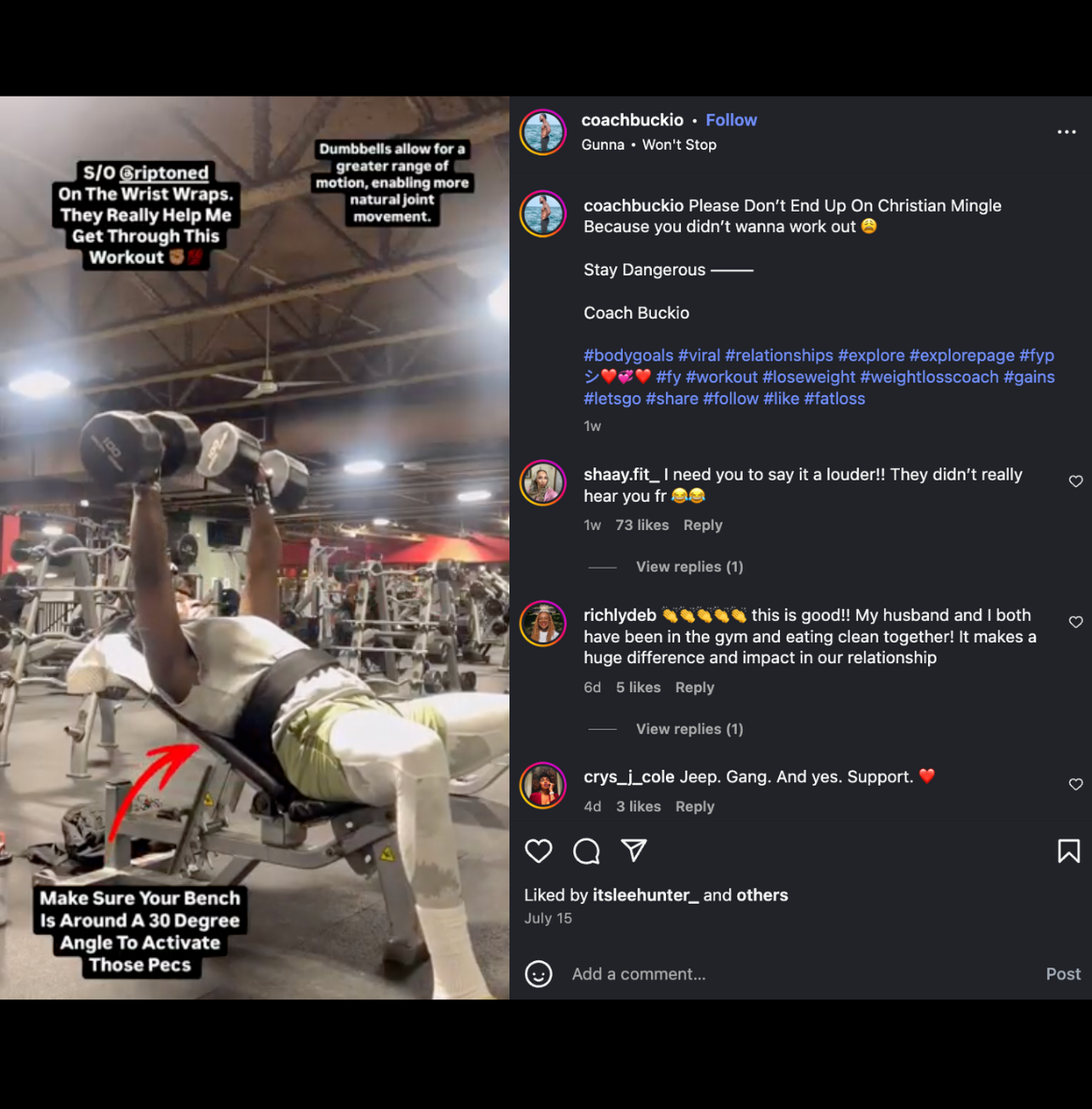
@coachbuckio
Pressing weight
Wrist Wraps Weight Training - Professional Support for Serious Lifters
When you're pushing heavy iron and chasing new PRs, your wrists take a serious beating. That's where our wrist wraps weight training collection comes in clutch.
These aren't just another gym accessory - they're your training partner's best friend, designed to keep you lifting heavier, longer, and safer.
Whether you're benching your bodyweight for the first time or going for that elusive 500-pound pull, proper wrist support makes all the difference between a successful lift and a potential injury.
Our wrist wraps weight training gear has been battle-tested by powerlifters, CrossFit athletes, and weekend warriors who refuse to let wrist pain hold them back.
We've seen too many lifters sidelined by preventable injuries, and frankly, that pisses us off.
Your training shouldn't be limited by inadequate gear, which is why we've obsessed over every detail - from the thumb loop placement to the wrap tension - to deliver support that actually works when you need it most.
Rip Toned USPA Wrist Wraps Weight Training Gear
Transform your lifting sessions with our premium wrist wraps weight training collection. Each pair delivers professional-grade support that competitive powerlifters and strength athletes demand. These lifting accessories provide targeted compression and stability during heavy pressing movements, overhead lifts, and intense training sessions.
Our weightlifting wrist wraps feature reinforced stitching, breathable materials, and adjustable compression levels to match your training intensity.
From 18-inch wraps for moderate support to 30-inch competition-grade wraps for maximum stability, we've got your wrists covered. Every pair includes durable thumb loops and secure velcro closures that won't fail mid-set.
Perfect for bench press training, powerlifting competitions, CrossFit workouts, and general strength training. These gym accessories help prevent wrist hyperextension, reduce joint fatigue, and allow you to focus on proper lifting technique without worrying about wrist discomfort.
Why Choose Wrist Wraps Weight Training for Your Training?
Picture this: you're halfway through your bench press session, and that familiar ache starts creeping into your wrists. Your form starts breaking down, you're cutting sets short, and suddenly your entire workout is compromised. Sound familiar? That's exactly why serious lifters swear by quality wrist wraps weight training gear. These aren't just strips of fabric - they're engineered support systems that keep your wrists in proper alignment when the weight gets serious.
The difference between training with and without proper wrist support is like night and day. With our wrist wraps, you'll notice increased stability during pressing movements, reduced post-workout soreness, and the confidence to push heavier loads knowing your joints are protected. We've designed these wraps based on feedback from competitive powerlifters who understand that every detail matters when you're chasing PRs. The result is support gear that actually enhances your performance rather than just providing a false sense of security.
Key Features of Our Wrist Wraps Weight Training
Our powerlifting wrist wraps aren't your typical gym store accessories - they're built with the same attention to detail that goes into competition equipment. Each wrap features heavy-duty elastic material that provides consistent compression without losing elasticity over time. This means your wraps will maintain their supportive properties through hundreds of training sessions, not just the first few weeks.
The reinforced thumb loop design ensures secure attachment that won't slip during heavy lifts, while our precision-cut velcro closures provide multiple adjustment points for personalized compression. We've also incorporated moisture-wicking technology into the fabric blend, because nobody wants to deal with soggy, smelly wraps after an intense session. These weight training accessories are machine washable and designed to maintain their shape and support characteristics even after countless wash cycles.
Benefits of Using Wrist Wraps Weight Training
Let's cut through the marketing fluff and talk real benefits. When you strap on a quality pair of wrist wraps weight training supports, you're not just adding another piece of equipment to your gym bag - you're investing in longevity and performance enhancement. The primary benefit is joint stabilization during heavy pressing movements, which allows you to maintain proper wrist alignment even when the load exceeds your natural joint stability limits.
Beyond just injury prevention, these lifting supports can actually help you lift more weight by providing a stable platform for force transfer. When your wrists are properly supported, more energy goes into moving the weight rather than stabilizing wobbly joints. Many lifters report immediate increases in their bench press, overhead press, and other pressing movements simply because they can focus on the lift instead of worrying about wrist discomfort.
Enhanced Protection
Your wrists aren't designed to handle the extreme loads that serious strength training demands. During heavy bench pressing or overhead movements, your wrists can hyperextend beyond their natural range of motion, leading to strain, inflammation, and potential injury. Quality wrist wraps weight training gear acts as an external stabilizer that prevents this dangerous hyperextension while maintaining functional range of motion.
The protective benefits extend beyond just preventing acute injuries. Regular use of lifting wrist wraps can help reduce the cumulative stress that leads to chronic conditions like tendinitis or joint degeneration. Think of them as insurance for your training longevity - a small investment now that pays dividends in terms of pain-free lifting years down the road. We've worked with physical therapists to ensure our wrap design promotes healthy joint mechanics rather than simply masking problems.
Improved Performance
Here's where things get interesting for serious lifters. Proper wrist support doesn't just prevent problems - it can actually boost your numbers. When your wrists are stable and properly aligned, force transfer from your arms to the barbell becomes more efficient. This means less energy wasted on joint stabilization and more power directed into moving heavy weight.
Many competitive powerlifters consider weightlifting wrist wraps essential equipment for peak performance. The compression and stability provided by quality wraps can help you maintain consistent bar path and technique even as fatigue sets in during long training sessions. We've seen lifters add 10-20 pounds to their bench press simply by upgrading to proper wrist support, not because the wraps magically make them stronger, but because they allow existing strength to be expressed more effectively.
Reduced Fatigue
Training fatigue isn't just about your muscles getting tired - joint fatigue plays a huge role in limiting performance during extended sessions. Without proper support, your wrists work overtime to stabilize heavy loads, leading to premature fatigue that affects your entire kinetic chain. Quality wrist wraps weight training supports reduce this unnecessary energy expenditure, allowing you to maintain intensity throughout your workout.
The fatigue-reducing benefits become especially apparent during high-volume training phases or when working with submaximal loads for multiple sets. Your wrists stay fresh longer, which means better form maintenance and more productive training sessions overall. This is particularly valuable for athletes following periodized programs where consistent quality training is more important than single-rep maximums.
Better Form
Form breakdown often starts with the weakest link in the kinetic chain, and for many lifters, that's the wrists. When your wrists start to fatigue or hyperextend during pressing movements, compensation patterns develop that can affect your entire lift. Proper lifting wrist support helps maintain optimal joint positioning, which translates to better overall movement mechanics.
Consistent form leads to more effective training adaptations and reduced injury risk throughout your entire body. When your wrists are stable and properly aligned, you can focus on engaging the right muscles at the right time instead of fighting to maintain joint position. This is especially important for newer lifters who are still developing movement patterns and muscle memory.
How to Choose the Right Wrist Wraps Weight Training
Choosing the right wrist wraps weight training gear isn't as simple as grabbing the first pair you see. Like any serious piece of equipment, the details matter, and understanding these details can mean the difference between supportive gear that enhances your training and expensive fabric that just gets in the way. The key factors to consider are wrap length, material construction, and closure system design.
Your training style, experience level, and specific needs should guide your selection process. A powerlifter preparing for competition has different requirements than a CrossFit athlete or someone just starting to explore heavier lifting. We've broken down the key considerations to help you make an informed choice that will serve your training goals for years to come.
Length Considerations
Wrist wrap length isn't just about having more material - it's about matching support level to your specific needs. Shorter wraps (12-18 inches) provide moderate support that's perfect for general strength training, bodybuilding, and lighter powerlifting work. These are ideal if you want wrist stability without feeling completely locked in, allowing for more natural movement patterns while still providing meaningful protection.
Longer wraps (24-36 inches) offer maximum support and are the go-to choice for competitive powerlifters and anyone working with near-maximal loads. The additional material allows for more compression layers and tighter support, but with increased rigidity comes reduced mobility. Competition-length wraps are essential for meet preparation and max effort training, but might be overkill for general fitness or moderate lifting sessions. Consider having both lengths available to match your wrap choice to your training intensity.
Material Quality
Not all elastic is created equal, and the material quality of your weightlifting wrist wraps directly impacts both performance and durability. High-quality wraps use a cotton-elastic blend that provides consistent compression without losing elasticity over time. Cheap wraps often use inferior elastic that becomes loose and unsupportive after just a few training sessions, making them worthless when you need them most.
Look for wraps with reinforced stitching at stress points, particularly around the thumb loop and velcro attachment areas. These are the failure points where cheap wraps typically fall apart first. Quality materials should also be moisture-resistant and machine washable without losing their structural integrity. The investment in premium materials pays off in longevity and consistent performance throughout the life of the product.
Closure System
The closure system is where many otherwise decent wraps fall short. A poor velcro design can make the difference between secure, consistent support and frustrating mid-set failures. Quality gym wrist wraps feature industrial-strength velcro with multiple adjustment points, allowing you to fine-tune compression levels based on your specific needs for each exercise.
The thumb loop design is equally critical - it should be reinforced to handle the stress of tight wrapping without tearing or stretching out. Some lifters prefer loops that can be removed during the lift, while others want them to stay in place for additional anchor point security. Consider your personal preferences and lifting style when evaluating closure system options, as this is something you'll interact with every single training session.
How to Put on Wrist Wraps Weight Training Gear Better and Faster
Wrist Wraps Weight Training for Specific Exercises and Training Types
Different lifting disciplines place unique demands on your wrists, and understanding these demands helps you optimize your wrap usage for maximum benefit. While all quality wrist wraps weight training gear provides basic joint support, the way you apply and adjust that support should vary based on your specific activities. Let's break down how to get the most from your wraps across different training styles and exercises.
The key is matching wrap tension and positioning to the specific movement patterns and load characteristics of your chosen exercises. What works perfectly for powerlifting might be overkill for CrossFit, and vice versa. Smart lifters adjust their approach based on the task at hand rather than using a one-size-fits-all strategy.
Wrist Wraps Weight Training for Bench Press
Bench pressing places unique demands on your wrists due to the combination of heavy loads and the need to maintain a straight wrist position throughout the movement. During heavy bench press training, your wrists must support significant weight while maintaining proper alignment to ensure efficient force transfer from your arms to the barbell. Quality powerlifting wrist wraps become essential equipment once you're working with serious weight.
The optimal wrapping technique for bench press involves positioning the wrap to support the wrist joint without interfering with grip positioning. Start the wrap just above your wrist joint and work toward your forearm, maintaining consistent tension throughout the wrapping process. The support should feel snug but not circulation-limiting, allowing you to maintain a strong grip while preventing hyperextension under load. Many competitive bench pressers prefer slightly looser wraps during warm-up sets, then tighten them progressively as the weight increases.
Powerlifting and Competition Use
Competitive powerlifting demands maximum support and stability, making long, tight wraps the standard choice for serious competitors. In powerlifting meets, wrist wraps weight training supports can mean the difference between a successful lift and a missed attempt, particularly during heavy bench press and overhead pressing events. Competition wraps are typically 36 inches long and applied with maximum tension to provide rock-solid wrist stability.
Meet preparation should include extensive practice with your competition wraps to ensure consistent application and timing. Many lifters develop specific wrapping routines that become part of their pre-lift ritual, helping to build confidence and ensure consistent support. The key is finding the balance between maximum support and maintaining enough mobility to execute proper lifting technique. Competition-grade weightlifting wrist wraps should feel secure without causing numbness or circulation issues during extended training sessions.
CrossFit and Functional Training
CrossFit and functional fitness training present unique challenges for wrist support due to the varied movement patterns and workout intensities involved. Unlike powerlifting, where wraps might only be needed for specific exercises, CrossFit workouts often combine multiple movement patterns that may or may not benefit from wrist support. The key is choosing versatile gym wrist wraps that can adapt to different exercise demands within a single workout.
For CrossFit applications, moderate-length wraps (18-24 inches) often provide the best balance of support and mobility. These allow adequate protection during heavy lifting segments while not interfering with gymnastic movements, kettlebell work, or other dynamic exercises that require wrist mobility. Many CrossFit athletes prefer wraps they can quickly adjust or remove between exercises, making ease of use a primary consideration alongside support quality.
FAQ Section
Do I really need wrist wraps for weight training?
If you're lifting heavy weights regularly or experiencing wrist discomfort during pressing movements, wrist wraps weight training supports can be incredibly beneficial. They're not essential for beginners or light training, but become valuable once you're handling significant loads or have previous wrist injuries.
What's the difference between 18-inch and 30-inch wrist wraps?
Length determines support level - 18-inch wraps provide moderate support perfect for general training, while 30-inch wraps offer maximum stability for powerlifting and heavy lifting. Longer wraps allow more compression layers but reduce wrist mobility.
Can wrist wraps help me lift more weight?
Quality wrist wraps weight training gear can help you lift more by providing stable wrist positioning and improved force transfer. Many lifters see immediate increases in pressing movements because they can focus on the lift rather than wrist stability.
How tight should I wrap my wrists for weight training?
Wraps should feel snug and supportive without cutting off circulation or causing numbness. Start with moderate tension and adjust based on exercise demands - heavier lifts typically require tighter wrapping for maximum stability and joint protection.
Are wrist wraps allowed in powerlifting competitions?
Yes, most powerlifting federations allow wrist wraps with specific length restrictions (usually up to 1 meter). Check your federation's rules for exact specifications, as some have material and design requirements for competition-legal lifting accessories.
Should beginners use wrist wraps for weight training?
Beginners should focus on developing natural wrist strength and proper form before relying on wraps. However, if you have previous injuries or experience pain during pressing movements, lightweight wraps can provide protection while you build strength.
How do I clean and maintain my weightlifting wrist wraps?
Most quality wrist wraps are machine washable in cold water. Air dry to preserve elastic properties and avoid fabric softeners that can break down the material. Proper care extends wrap life and maintains consistent support characteristics.
What exercises benefit most from wrist wraps weight training support?
Pressing movements like bench press, overhead press, and push-ups benefit most from wrist support. Heavy front squats and clean variations also benefit from wrist stability. Pulling exercises typically don't require wrap support.
Can I wear wrist wraps for CrossFit workouts?
Yes, but choose versatile wraps that don't interfere with varied movements. Moderate-length wraps work best for CrossFit since they provide support during lifting segments while allowing mobility for gymnastic and dynamic exercises within the same workout.
How long do quality wrist wraps typically last?
High-quality wrist wraps weight training supports can last 2-3 years with regular use if properly maintained. Cheaper wraps may lose elasticity within months. Investment in quality materials pays off in longevity and consistent performance over time.
Should I use wrist wraps for every workout?
No, use wraps strategically for heavy pressing movements or when experiencing wrist discomfort. Overuse can lead to dependency and reduced natural wrist strength. Save them for when you actually need the support rather than wearing them constantly.
What's the difference between wrist wraps and wrist straps?
Wrist wraps provide joint support and stability for pressing movements, while wrist straps assist grip strength during pulling exercises like deadlifts. They serve completely different purposes - wraps for joint protection, straps for grip assistance.
Can wrist wraps prevent lifting injuries?
Quality wrist wraps weight training supports can help prevent wrist hyperextension and reduce joint stress during heavy lifting. While they're not injury-proof, they significantly reduce risk when used properly alongside good technique and appropriate training progression.
What material should I look for in premium wrist wraps?
Look for cotton-elastic blends with reinforced stitching at stress points. Quality materials maintain elasticity over time and resist moisture buildup. Avoid cheap all-elastic wraps that lose support quickly or rough materials that cause skin irritation during extended use.
How do I know if my wrist wraps are too tight or too loose?
Properly adjusted wraps feel secure and supportive without causing numbness, tingling, or color changes in your hands. You should be able to maintain a strong grip while feeling stable wrist support. Adjust tension based on exercise demands and personal comfort.
Covered with a lifetime replacement warranty
Rip Toned wrist wraps are covered with our Lifetime Replacement Warranty

